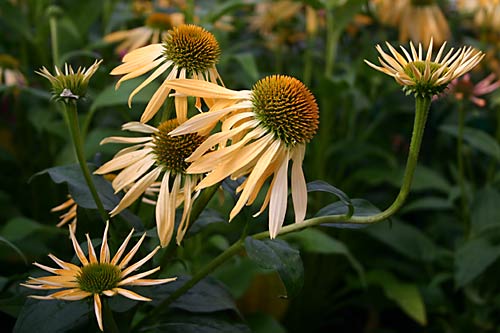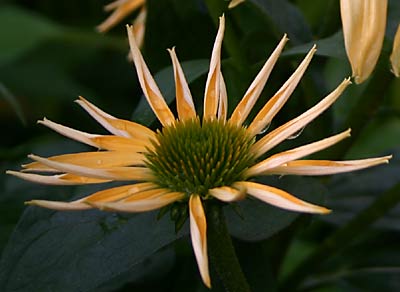Echinacea 'Matthew Saul'
CONEFLOWER
Trade Name: Harvest MoonTM
Family: Asteraceae
Pronounced: ek-in-AY-see-ah
Quick Jumps
Growing Guide
Rainy Side Notes
GROWING GUIDE

Garden.
Plant Group:
Perennial.
Hardiness:
Sunset zones: A2, A3; 1-24.
USDA zones: 5-8.
Heat zones: 9-1.
Mature size:
Height: 24-29 inches (60-75cm).
Width: 18 inches (45 cm).
Flowering period:
Midsummer to early autumn.
Flowering attributes:
Blossomss open with sweet-scented, orange-yellow petals that curl upward to reveal white underneath. As the flower ages, the petals relax downward, almost vertically, taking a more typical coneflower stance. It keeps its rich hues through the process until it ages to a straw color.
Leaf attributes:
Slender, lance-shaped leaves.
Growth habit:
Clump-forming.
Light:
Grows best with morning sun and afternoon shade; however, it is full sun tolerant.
Soil:
Humus rich, well-drained soil.
Feeding:
Side dress with compost or manure. Fertilize in spring with a complete organic fertilizer.
Propagation Methods:
Divide in autumn or spring.
Pruning Methods:
Dead head flowers for longer bloom period.
Pests and Diseases:
Leaf miners and occassionally powdery mildew and fungal leaf spots are a problem.
Rainy Side Notes

The avalanche of outstanding, new coneflower hybrids showing up in the nursery trade is astounding. E. ‘Matthew Saul' is no exception. More commonly known as Harvest MoonTM, this cultivar is right now my favorite echinacea hybrid. That may change with more hybrids breeching new color barriers.
Breeder Richard Saul, from ItSaul Plants developed this from two unknown hybrids, with E. purpurea and E. paradoxa in its parentage. When the flower ages and the petals reflex, you can see that E. paradoxa is in its lineage.
As with most echinaceas, this cultivar is a great choice for cut flowers, especially with its soft hues that will add a beautiful aspect to many bouquets.
For fresh flowers, it is best to harvest when petals are expanding. Flowers last 7-10 days in a vase when a preservative is used. When harvesting only for the orange disk, allow the petals to mature before harvesting so the petals will be easy to remove. For drying purposes, remove petals and hang to dry.Photographed in author's garden.

Gardening for the Homebrewer: Grow and Process Plants for Making Beer, Wine, Gruit, Cider, Perry, and More
By co-authors Debbie Teashon (Rainy Side Gardeners) and Wendy Tweton
Copyright Notice | Home | Search | Perennials

